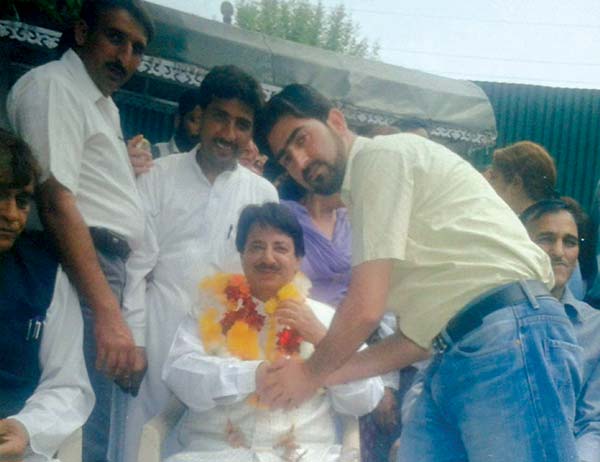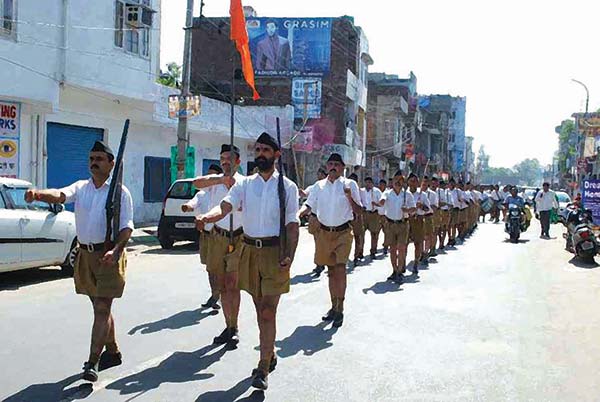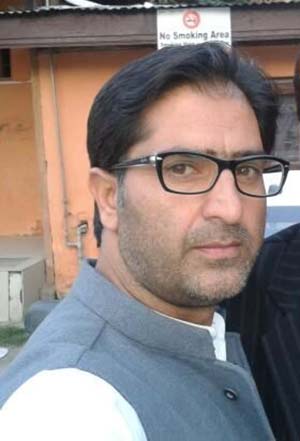Unlike journalism, RTI has empowered people to the extent they wish to be. A Srinagar politician close to Ghulam Nabi Azad keen to know what happens to the costly space around started using RTI to understand trends. One RTI, he says, helped him trace Nagpur in Srinagar, reports Bilal Handoo

Toward the fag-end of 2015, when “source-based”, “insider-quoted”, “unconfirmed” reports appearing in Jammu newspapers claimed that RSS’s nerve centre is coming up in Srinagar, perhaps not many heads were turned around. By then, however, an activist from Srinagar’s Jawahar Nagar had spotted “something shady” in Rajbagh. After exhaustive exercise, the man now believes that RSS has a “grand” address in Srinagar.
But a year before the revelation, the flood-ravaged Rajbagh had begun throwing surprises. Amid reconstruction boom, the activist noticed cropping up of new, unusual structures in the area. Being an RTI activist, probing came naturally to him. Among the buildings, a brick-colour building near a paramilitary camp intrigued him the most. He began fact-finding. A year later, he concluded his fact-finding and feels vindicated.
The RTI activist who goes by the name of Sherzod Khan, originally Gulsher Khan, is a self-confessed Ghulam Nabi Azad follower. As a student activist, Sherzod once sat on hunger strike for days in Amar Singh College to revoke the circular declaring most of his mates failed in one subject. “While everyone was declared pass, I was failed,” Sherzod says. With the result, he never had his graduation.
After giving up studies, he began running gym in his locality, where he also imparted martial arts training to boys. Then, he was a branded ‘angry young man’, who would never desist taking cudgels with the ‘powerful’. For many unionists in the area, this daring son of a middle class family was an apt political substance. Shortly, Congress’s Peerzada Mohammad Sayeed baptised him into politics by arranging his meeting with Ghulam Nabi Azad—then JK Congress boss.
It was 2005 and on Congress’s ticket, Sherzod contested Municipal elections from Srinagar’s Ikhrajpora. He lost. And shortly his opponent fell to ‘mysterious bullets’, forcing him to flee home to camp in Jammu for four months.
Once back, Sherzod focussed more on his contracting job than politics. But perhaps, the 40-year-old man knew his talents lie somewhere else—activism. The deadlock finally ended months before the 2014 floods would render him homeless, like thousands.
He jumped into activism arena with a belief to unearth scam of illegal construction boom in Srinagar. “Honesty speaking,” says Sherzod, a father of two sons, “Srinagar is an orphaned city, where everyone calls shots, makes fortune and ends messing it up. None seems to give a damn about its welfare.” When the thought made him restless, he donned robes of an RTI activist.
To begin with, he filed an RTI, seeking information why plum posts are merely being enjoyed by a certain blue-eyed officials? The reply sought by him was bound to upset many on hot seats. The cause shortly had its consequences when unknown numbers began buzzing him up, even during midnights, threatening him to back off. But before something could come up, floods struck valley—making mess of everything.
Then came flood relief along with compensation cheques. Sherzod was too sharp to detect discrepancies in the whole process. “When I saw even influential men from Jawahar Nagar whose houses were partially damaged lined up to receive cheques worth Rs 75,000—meant for fully damaged house,” he says, “I could sense that the whole game plan was fixed.”
And when his home was still flood-soaked, he filed an RTI, seeking names of those who availed Rs 75,000 cheques in Jawahar Nagar. The smooth reply meant humiliation to some known names—some of whom were big bosses in state administration. 100 days passed, but no reply came. When it finally came, Sherzod found the data confused. He could feel both red-herring and red-tapism involved in the whole procedure. While scanning the data under candle lights, he zeroed in on the names of top bureaucrats whose houses were partially damaged—yet had claimed Rs 75,000. “Everyone was involved in flood relief racket,” he says, “from DC to small patwari.”
But perhaps his best was yet to come. And when finally it came, it gave him sleepless nights.
While keeping a ‘hawkish’ eye on the reconstruction boom in his belt, a building in Rajbagh caught his attention. He had never seen the building on the spot before the floods. He went for the spot inspection, and instantly sensed something unusual. “When I entered the premises, I was told, ‘leave immediately’,” Sherzod recalls. “When I persisted and asked the men there, ‘whose building is this and what is it all about?’—as it didn’t appear a normal structure to me.” Instead of getting answers, he was shown the door. Sherzod then stepped out as a suspected man, sensing: the building is an obvious departure from the usual.
The next thing he did was filing an RTI in Nazool section of Divisional Commissioner’s office—where the body language of officials left nothing for his imaginations. “When I mentioned the structure, its location and questioned its existence, the official became alert,” Sherzod says. “They began talking to each other in a coded language—‘acha, so he has come to seek details of that structure’.”
Later one of his friends in Nazool briefed him about “that structure”. “Why are you playing with fire,” Sherzod claims his friend told him. “The structure you are inquiring about is no ordinary structure; it is RSS’s Srinagar office.” Instead of feeling discouraged, the revelation only pumped up the activist to unearth the truth behind the three-storey building.

But reply to his RTI took its own time. When it finally arrived, it revealed some bitter facts: the permission for constructing structure on “government land” was granted through Order No. 1470 of 2015, Dated: 28/10/2015. The permission was issued in favour of Ish Kumar Mehta, s/o RC Mehta through Himat Mehta and Dushaan Mehta, s/o Jagdish Kumar Mehta of Rajbagh. The final order came from Srinagar Municipal Commissioner’s office—the competent authority for building permission.
“It was one of the many structures that had cropped up in an influential neighbourhood of Srinagar,” Sherzod says. “Amid city’s construction boom, you never know, what is that next structure coming up in your neighbourhood.” Among many other things, the RTI reveals that the structure is meant for a Praying Hall—“something very unique to RSS”.
Till now, perhaps, everybody was caught in classical Hamlet Trap about RSS’s Kashmir presence: to be, or not to be. But last December, reports said that RSS was all set to start its operations in Kashmir with its office at posh Rajbagh locality. The news reports sounded ‘run of a mill’ type at that point of time—until Sherzod claimed his “discovery”.
But Kashmir forays of Rashtriya Swayamsevak Sangh (RSS)—the Hindu nationalist party mobilising public opinion against the blitz of “Islamic imperialism” in “Hindu” Kashmir—appear resurgent than recent.
Founded by a Nagpur doctor in 1925, RSS draws inspiration from Adolf Hitler’s ideology of race purity, but supports Jewish State of Israel.
In 1940s, RSS’s first Shakha came up in Jammu with Prem Nath Dogra its first Sanghchalak. By 1944, Prof Balraj Madhok started a Shakha in Srinagar and shortly then RSS chief MS Golwalkar visited Srinagar to address a public rally. Later on Oct 18, 1947, Golwalkar was face to face with Maharaja Hari Singh “convincing” him for JK’s accession to India. In November that year, RSS formed Praja Parishad party in Jammu under Prem Nath Dogra’s leadership to oppose Abdullah’s “partisan attitude” toward Jammu province. For RSS, Sheikh Abdullah’s Kashmiri nationalism call was always linked with “Islamic imperialism”.
By January 30, 1948, when Nathu Ram Godse, an RSS man assassinated MK Gandhi, Sangh launched its political arm, Bhartiya Jana Sangh (which later became Bhartiya Janata Party) to attack Nehruvian politics in Kashmir.
1953 was RSS’s watershed year in JK. That year, the party spearheaded Praja Parishad agitation against JK’s special status under Article 370. Besides terming JK’s accession to India complete and final, the Praja agitators pitched for one constitution, one flag, one prime minister (ek vidhan, ek nishan, ek pradhan). But as Abdullah cracked whip on agitators, RSS’s Akhil Bhartiya Pratinidhi Sabha in its March 1953 resolution condemned the “repressive” Abdullah.
In between entered Dr Shyama Prasad Mukherjee, defying JK’s permit system only to land up in jail on May 11, 1953—where he died, a month later. Later RSS created fierce public opinion against “anti national” NC, thus accelerating Abdullah’s ouster.
It remained active and by 1982, RSS backed another agitation in JK under Hindu Raksha Samiti (HRS) banner against state government’s plan of introducing a Bill in Assembly seeking control of Hindu shrines. In face of agitation, the government had to withdraw the Bill. Then in summer 1985, RSS thwarted state government’s move to construct a mosque inside Jammu secretariat. Later, RSS was at forefront to oppose autonomy resolution adopted by J&K Assembly in June 2000. The rightwing party was even critical of Vajpayee’s Kashmir handling.
2008 proved its landmark year in Jammu when it worked on Amarnath land row. And by 2014 fall, RSS restarted its Kashmir operations when some of its pracharaks participated in flood relief works. And now, RSS-backed Muslim Rashtriya Manch (MRM) is planning to host a mega convention at Srinagar in coming May.

Unconcerned about follow-up, Sherzod is busy hawking around the Srinagar—doing what he has tasked himself to do: to check the sloth. But the activist is candid enough to admit that things wouldn’t have been the same for him, had there been no RTI. “My political affiliation apart,” he says, “but I firmly believe that RTI is an empowering weapon of the weak.”
These days, Sherzod is busy probing Gupkar, Kashmir’s ‘power street’. He says the biggest shady deals happen around the power corridors because only powerful know how to use the system to make big bucks. Wait for new revelations.

